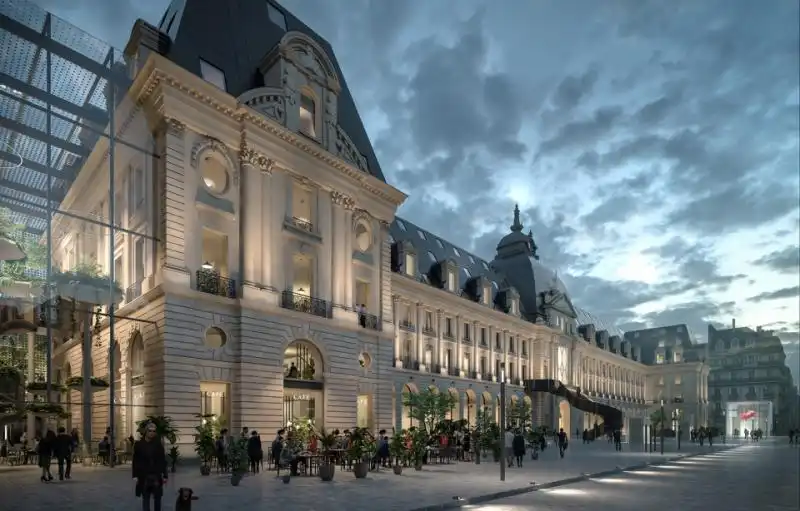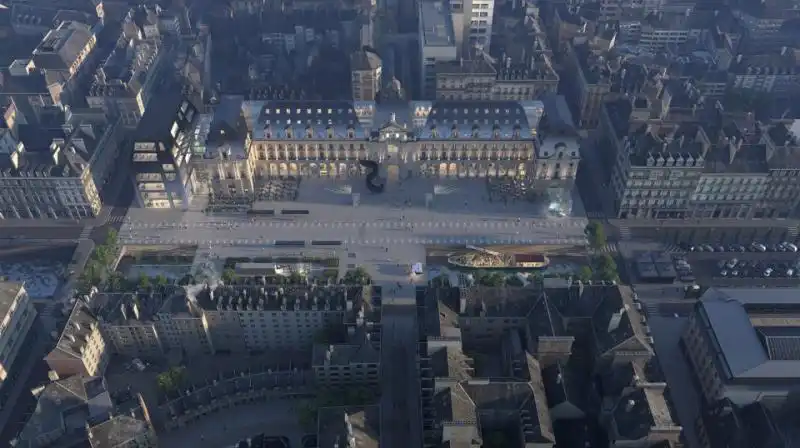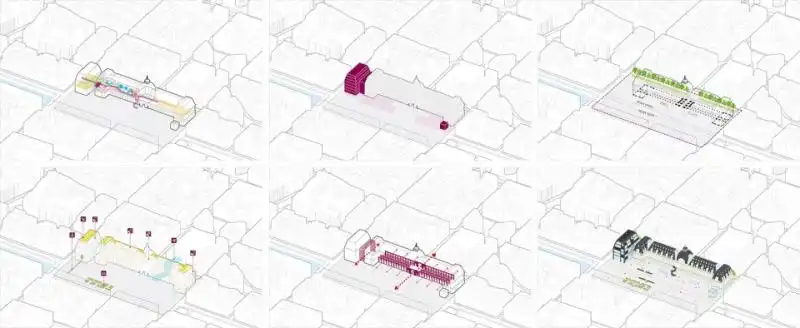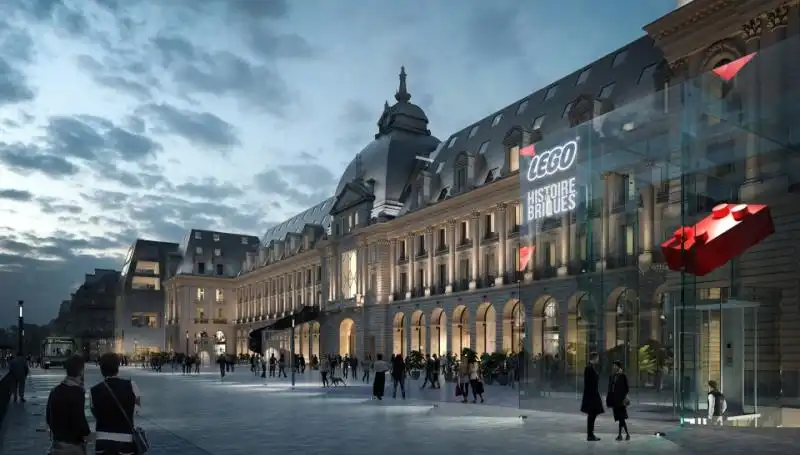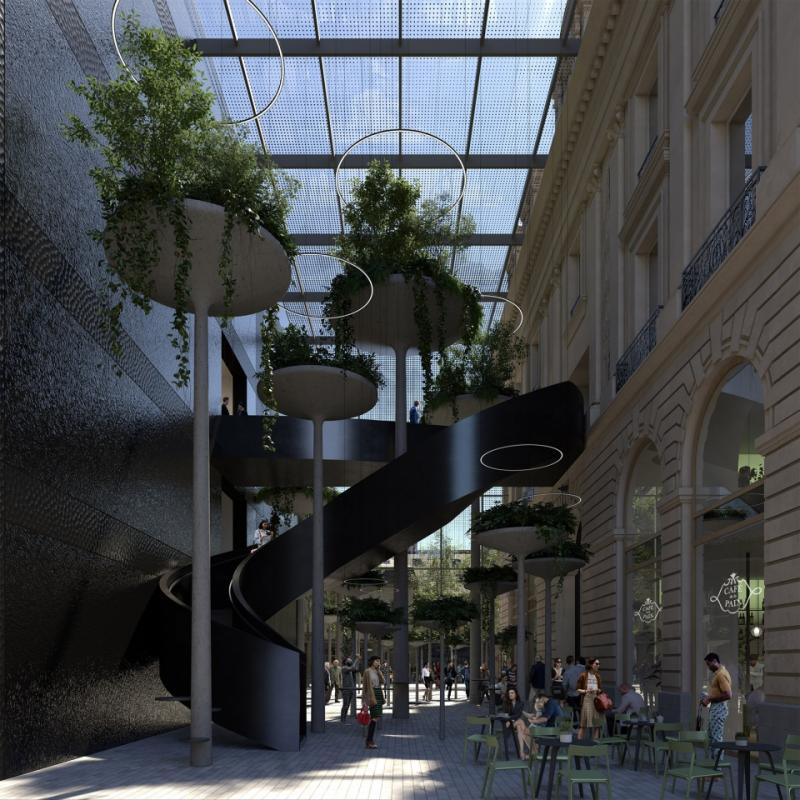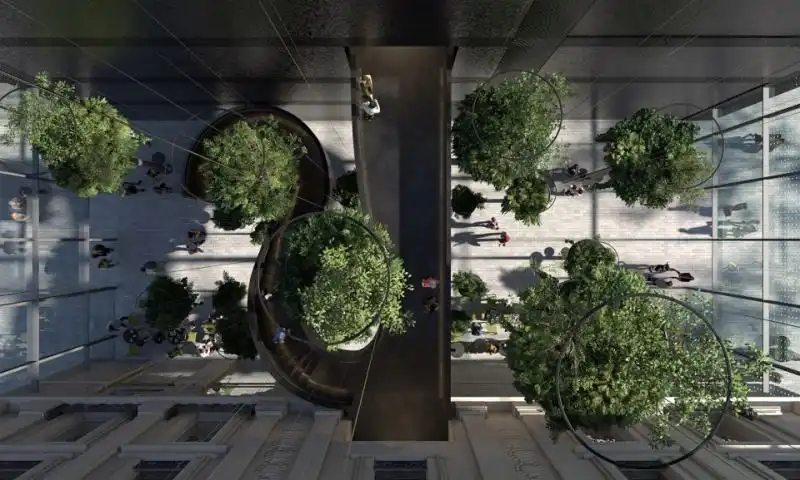MVRDV赢得了雷恩Palais du Commerce商业大楼翻新及扩建项目竞赛优胜。MVRDV将与Bernard Desmoulin合作,对这座18000平米的雷恩地标性建筑进行改造,让建筑和周边社区重获新生。设计方案将把这座曾经的公共建筑转变成城市主要商业街,提升项目在公众生活中的重要性。
MVRDV has won the competition to renovate and extend the historic Palais du Commerce in Rennes. Developed alongside co-architects Bernard Desmoulin for developers Frey and Engie Avenue, the 18,000-square-metre redevelopment of the notable Rennes landmark will signify a renaissance for both the building and its surroundings. MVRDV’s proposal will reactivate the Place de la République and turn this former public building into a centrepiece of the city’s main commercial street, raising it to the level of significance that was initially intended.
▼效果图,改造后建筑外观,external view of the building after renovation
Palais du Commerce商业大楼位于雷恩市中心南部,经过当地建筑师Jean-Baptiste Martenot 和Emmanuel Le Ray在1885年和1929年两次建设,曾作为邮局、图书馆和艺术学校使用。如今这栋建筑和当地居民的生活严重脱节,MVRDV希望通过这次改造和扩建为建筑增添新的功能,让它重新成为城市生活的一部分。
新的建筑尺度宜人,成为了人们消磨时间的好去处。在市政部门协助调整巴士运营的努力下,建筑师将大楼南侧的街道改造成了一片景观台地,并且可以部分和Vilaine河产生联系。
▼鸟瞰效果图,改造后的建筑加强与城市的联系,renovation will rectify the building and open it to the city
Located in the southern part of Rennes’ city centre, the Palais du Commerce was originally constructed in two stages between 1885 and 1929 as a post office, library and arts school by local architects Jean-Baptiste Martenot and Emmanuel Le Ray. Today, the building is poorly integrated into the life of Rennes, with most residents unaware of most of the activities inside. The renovation and extension designed by MVRDV aims to rectify this, activating the building with new uses and a design that communicates these new functions to passers-by.
On the urban scale, the scheme will favour pedestrians and transform the Place de la République into an inviting public square in which to spend time. Alongside the efforts of the municipality to reorganize the bus network, the project plans to convert the Rue du Pré Botté, on the Palais du Commerce’s southern side, into a landscaped pedestrian area animated by terraces. The proposal also recommends the partial re-opening of the cover of the river Vilaine.
▼效果图,改造后的广场加强了与河流的联系,the public space will partly open to the river after renovation
设计在尊重建筑历史特点的同时,增强了它的透明性。原本的窗户被巨大的玻璃板替代,一层拱廊中设置玻璃店面,为商业单元提供了更多空间,并且保留了拱廊曾经的视觉效果。
The design is respectful of the existing building while taking a critical approach to its drawbacks. A key approach was to increase the building’s transparency: windows will be replaced, with larger panes of glass giving improved visibility. Meanwhile on the ground floor, glass storefronts will be added in the arches of the arcade in order to provide more space for the commercial units. This alteration is designed in such a way that the visual effect of the arcade is preserved, as the walls introduced into the arcade separating the different shop units will also be glass.
▼效果图,巨大的玻璃提升建筑的通透性的同时保持建筑原本的视觉效果,large glass panels will gain transparency to the building while remaining its original appearance
“改造后的Palais du Commerce商业大楼不仅会成为当地地标,还会成为催化剂,将整个地区转变为受人欢迎的目的地。”MVRDV创始合伙人Nathalie de Vries说道,“我们的设计尊重建筑历史,并且放眼未来,帮助雷恩实现对城市未来的规划。加建的部分极具现代感,将成为建筑历史上崭新的一页。”
“Not only is Palais du Commerce a local landmark, but its transformation will turn the Place de la République into a popular destination and act as a vital catalyst for its surroundings”, says Nathalie de Vries, founding partner of MVRDV. “Our design approaches this task with an appreciation of the building’s history, but also with an eye towards the future, helping Rennes to achieve its urban vision. The additions that we will make are clearly modern in character, clearly showcasing this design as the latest chapter in the building’s storied history.”
项目建筑面积18000平米,其中12000平米为老建筑改造。加建的6000平米中包含新的商店,一栋酒店,办公室,联合办公空间,多种多样的休闲空间(如乐高博物馆、活动室、电子音乐吧等)以及一个由Thierry Marx大厨开办的酒店管理和烹饪学校。
The 18,000-square-metre project – which includes 12,000 square metres in the existing building and a 6,000-square-metre extension – introduces new shops, a hotel, offices, a coworking space, a variety of leisure spaces (including a LEGO museum and event space and an electronic music bar), and a school for the kitchen and hotel industry led by chef Thierry Marx.
▼分析图,analysis diagram
建筑中央加建了一座巨大的旋转楼梯,成为了立面改造上最惊人的一笔,弥补了原本建筑缺少开阔的前厅空间这一不足。加建部分在建筑布局上具有很强的功能性,它在二层形成了一个接待区,成为了人们通往上层空间的纽带。
The most striking exterior change to the existing building is the addition of a grand, winding staircase at the centre of the façade, a tongue-in-cheek reference to the fact that the original building did not have the elegant foyer space or other spatial centerpiece typically found in such grand buildings. This addition also serves a very functional role in the new layout: on the second floor, a welcoming reception area sets up a path through the building’s upper levels.
▼效果图,立面中部加建了一座旋转楼梯,an additional winding staircase at the center of the facade
加建部分位于老建筑东部,沿用木结构,外观则更为现代,由黑色带纹理的陶瓷和玻璃板组成,与周边建筑的黑色屋顶相呼应。两个部分通过玻璃廊道相连,行人可以从中穿过。一座旋转楼梯将建筑的二层与地面广场连接在一起。
The extension, on the eastern end of the building, comprises a wood construction that imitates the forms of the original building while adopting a modern architectural expression, with a façade of black textured ceramic and opaque glass panels which references the black slate roofs of the Palais du Commerce and other buildings in the city centre. This will be respectfully connected to the existing building by a glass gallery that, like the passage through the Palais, offers permeability at street level. Inside, a second winding staircase connects the route through the building’s second floor level to the new entrance on Place de la République.
▼效果图,加建建筑和老建筑以玻璃廊道相连,glass gallery connect the original building with the extension
▼效果图,玻璃廊道内部,加建部分的立面和原始建筑形成对比,旋转楼梯连接不同楼层,inside the glass gallery, facade of the extension contrast with the original building, a winding staircase connects different levels
▼效果图,行人可以从建筑一侧穿行到另一侧,pedestrian could walk through the glass gallery on the ground level
设计还提高了建筑的使用效率。地下层延伸到广场下,获得了更多面积。屋顶则设置了新的餐厅,充分利用了穹隆结构独特的氛围。各个空间相互连通,人们可以畅通无阻地从建筑的一侧走到另一侧。新老建筑间的空间由玻璃覆盖,维持了建筑原本的天际线。
The new design makes the most of invisible methods to intensify the building’s usage. The basements of the building will not only be used more effectively, but will be extended underneath the Place de la République to create more floor area. The roof will also be occupied, with a bistro included in the building’s central dome that takes advantage of the existing atmosphere of the dramatic structure. The spaces between the different roofs will be opened up to create a continuous passage from one end of the building to the other, with the gaps between the roofs and the dome covered with glass, so that the original skyline of the building is maintained.
▼效果图,穹隆下的屋顶餐厅,roof bistro under the dome
项目计划于2022年开始施工,2025年完成。
MVRDV designed the Palais du Commerce alongside co-architects Bernard Desmoulin. The principal developer for the project is Frey, with Engie Avenue as co-developer. Construction will begin in 2022, with completion expected for 2025.
